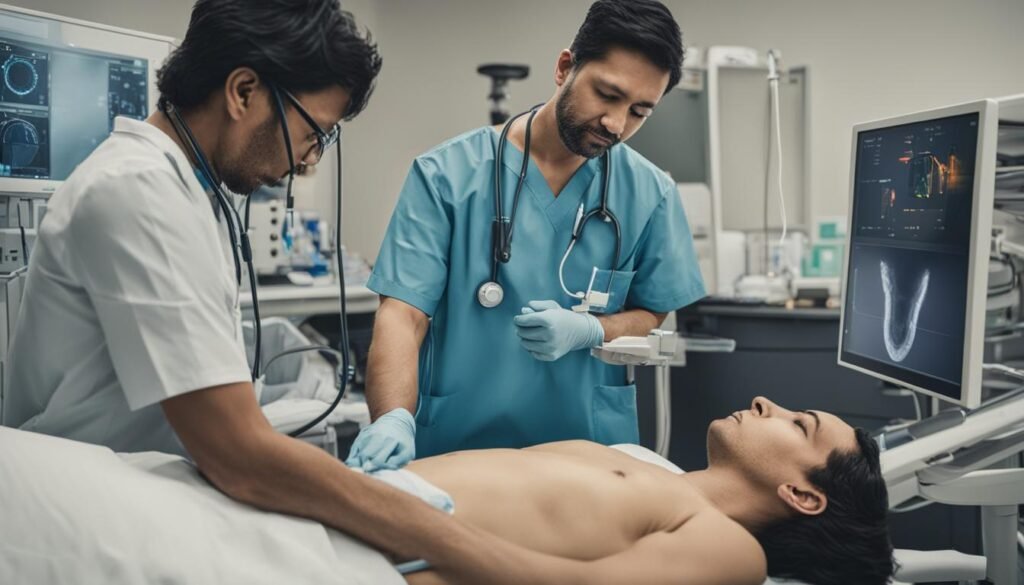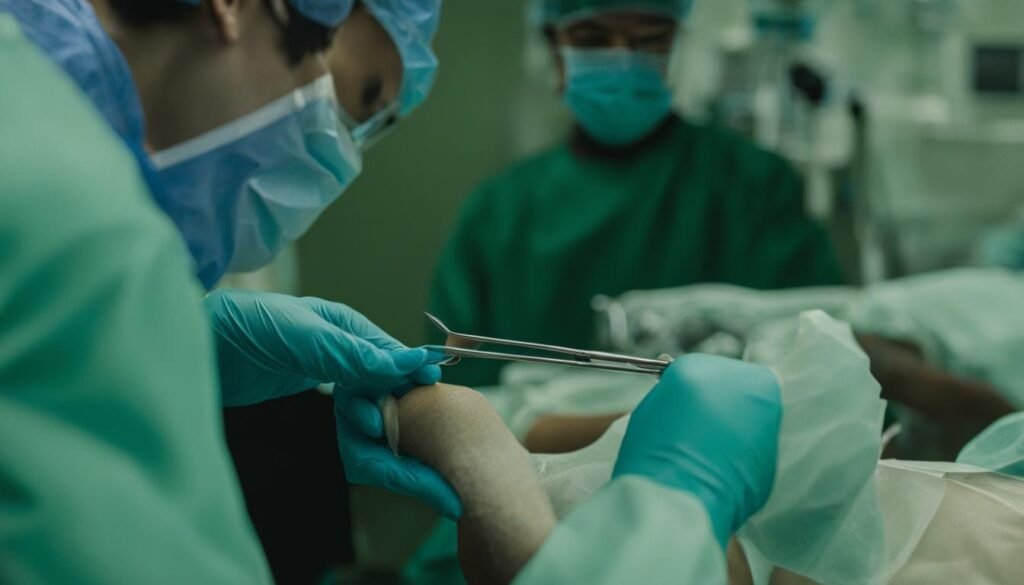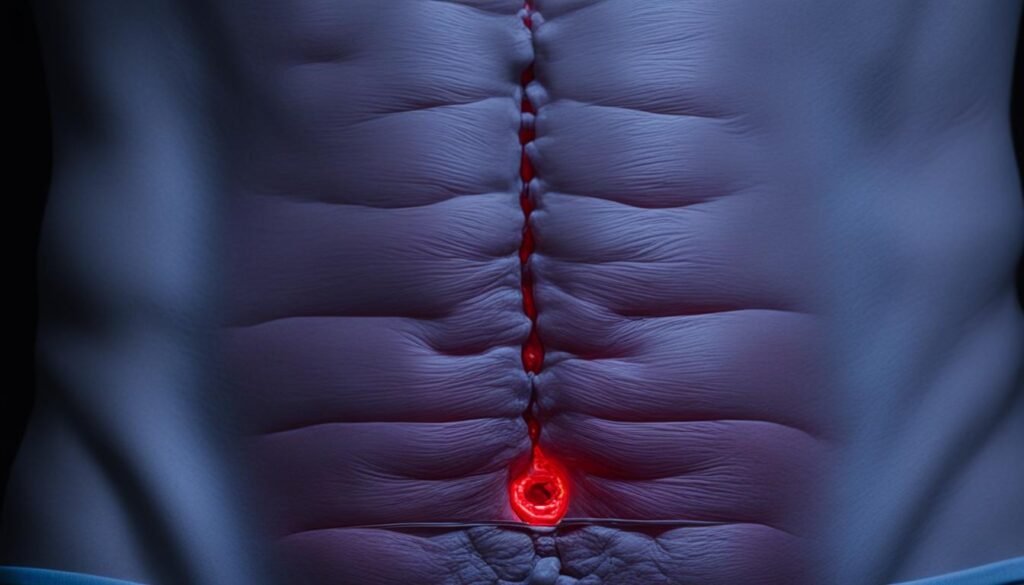Welcome to our blog post on recognizing the early signs of appendicitis early. Appendicitis is a condition that involves inflammation of the appendix, a small organ attached to the colon. It is important to be aware of the early signs and symptoms of appendicitis as prompt medical attention is crucial in preventing complications.
Table of Contents
ToggleOne of the early signs of appendicitis is severe and sudden abdominal pain. This pain typically starts near the belly button and then shifts to the lower right side of the abdomen. It is important to note that these symptoms may not be present in all cases and can vary depending on the age group. Other common symptoms include nausea, vomiting, loss of appetite, constipation or diarrhea, inability to pass gas, low-grade fever, and stomach swelling.
Recognizing these early signs and symptoms of appendicitis is essential to ensure timely medical intervention. Delaying treatment can lead to complications such as a burst appendix, infection, and organ damage. By seeking immediate medical attention, you can prevent these risks and increase the chances of a successful recovery.
In the following sections, we will discuss the causes, risk factors, and symptoms of appendicitis, as well as the importance of seeking medical help and available treatment options. Stay tuned to learn more about this condition and how to best manage it.
Causes and Risk Factors of Appendicitis
Appendicitis is a condition that occurs when the appendix, a small pouch attached to the colon, becomes inflamed. While the exact cause of appendicitis is still unknown, several factors can contribute to its development. The most common cause is a blockage in the appendix, which can result from various sources, including:
- Hardened fecal matter
- Swollen lymphoid tissue
- Foreign objects
- Tumors
This blockage can lead to inflammation and infection in the appendix, causing the symptoms associated with appendicitis.
Furthermore, certain risk factors can increase the likelihood of developing appendicitis. These include:
- Age: Appendicitis is most common in teenagers and young adults.
- Family history: Having a close relative who has had appendicitis may increase your risk.
- Inflammatory bowel disease: Conditions such as Crohn’s disease or ulcerative colitis can raise the risk of developing appendicitis.
It’s important to note that while these factors may increase the likelihood of developing appendicitis, the condition can still occur in individuals without these risk factors.
| Cause | Risk Level |
|---|---|
| Blockage in the appendix | High |
| Inflammatory bowel disease | Moderate |
| Family history of appendicitis | Low |
| Age (teenagers and young adults) | Low |
| No known risk factors | Unknown |
Symptoms of Appendicitis in Different Age Groups
The symptoms of appendicitis can vary depending on the age group. It is important to recognize these symptoms to ensure prompt medical attention and appropriate treatment.
Symptoms of Appendicitis in Children:
Appendicitis symptoms in children may include:
- Tenderness throughout the body
- Lack of appetite
- Changes in bowel movements
Symptoms of Appendicitis in Adults:
In adults, the symptoms of appendicitis may be less severe and specific. They can include:
- Nausea
- Vomiting
- Fever
Symptoms of Appendicitis in Pregnancy:
Pregnant women may experience symptoms similar to those in adults. These can include:
- Abdominal pain
- Nausea
- Vomiting
- Fever
Although abdominal pain is the most common symptom in all age groups, it is essential to note that not all individuals will experience the same symptoms. Some may have atypical or less common symptoms. If you or your child experience significant abdominal pain or any other symptoms of appendicitis, it is crucial to seek immediate medical attention for proper diagnosis and treatment.

| Age Group | Common Symptoms |
|---|---|
| Children | Tenderness throughout the body, lack of appetite, changes in bowel movements |
| Adults | Nausea, vomiting, fever |
| Pregnancy | Abdominal pain, nausea, vomiting, fever |
Diagnosing Appendicitis
When it comes to diagnosing appendicitis, healthcare providers follow a comprehensive approach that involves reviewing symptoms, conducting physical examinations, and ordering pertinent medical tests. These steps help ensure an accurate diagnosis and appropriate treatment plan.
First and foremost, a healthcare provider will carefully assess the symptoms reported by the patient. Chronic appendicitis symptoms such as severe abdominal pain, accompanied by nausea, vomiting, and loss of appetite, are characteristic of appendicitis. The provider will also take into account the patient’s medical history to identify any risk factors or previous episodes of appendicitis.
Following the symptom assessment, a physical examination is performed. This examination helps gather additional information to support the diagnosis. Healthcare providers may gently apply pressure to specific areas of the abdomen to assess tenderness and possible inflammation. Pelvic and rectal exams may also be conducted to rule out other potential causes of the symptoms.
To confirm the diagnosis, medical tests are ordered. The most commonly used tests for diagnosing appendicitis include blood and urine tests. These tests help determine the presence of infection and the extent of inflammation in the body. In some cases, imaging tests such as ultrasound or computed tomography (CT) scan may be necessary. These tests provide detailed images of the appendix and surrounding structures, aiding in visualizing any abnormalities or signs of infection.
It is important to note that the specific diagnostic approach may vary depending on the individual case and the healthcare provider’s judgment.
| Diagnostic Method | Description |
|---|---|
| Symptom Assessment | Reviewing the reported symptoms and medical history. |
| Physical Examination | Applying pressure to the abdomen and performing pelvic and rectal exams. |
| Blood and Urine Tests | Evaluating infection markers and identifying inflammation. |
| Imaging Tests | Visualizing the appendix and surrounding structures through ultrasound or CT scan. |
By following a systematic diagnostic process, healthcare providers can accurately diagnose appendicitis and ensure appropriate interventions for timely management and care.

Treatment Options for Appendicitis
The treatment for appendicitis typically involves a combination of antibiotics and surgery. Antibiotics are administered to combat the infection and reduce inflammation. The most common surgical procedure for appendicitis is an appendectomy, which entails the removal of the inflamed appendix. Depending on the severity and presentation of the condition, there are two different types of appendectomy surgeries that may be performed.
Laparoscopic Surgery
In laparoscopic surgery, several small incisions are made in the abdomen, and specialized tools and a camera are used to remove the appendix. This minimally invasive procedure offers the benefit of a faster recovery time and reduced scarring compared to open surgery.
Laparotomy Surgery
In Appendicitis laparoscopic surgery, a single larger incision is made in the lower right side of the abdomen to remove the appendix. This procedure may be necessary in cases where laparoscopic surgery is not feasible or when the appendix has already ruptured.
Ultimately, the choice of surgical procedure depends on various factors, such as the severity of the appendicitis and the surgeon’s expertise. Your healthcare provider will determine the most suitable treatment approach for your unique situation.

| Procedure Type | Advantages | Disadvantages |
|---|---|---|
| Laparoscopic Surgery | Faster recovery time Reduced scarring Less postoperative pain | May not be suitable for all cases Requires specialized equipment and training |
| Laparotomy Surgery | Suitable for cases with a ruptured appendix Allows for thorough examination of the abdominal cavity | Longer recovery time Larger incision and potential for more scarring Increased postoperative pain |
Complications of Untreated Appendicitis
If appendicitis is left untreated, it can lead to serious complications. One of the most common complications is a burst appendix, which can cause infection in the abdomen (peritonitis) or the formation of a pocket of pus (abscess). Peritonitis and abscess can be life-threatening and require immediate medical attention. Other potential complications include the spread of infection to other organs and tissues, sepsis, and septic shock. Prompt treatment is essential to prevent these complications and reduce the risk of mortality.
Untreated appendicitis can have severe consequences on a person’s health and well-being. Table 1 provides an overview of the potential complications associated with untreated appendicitis:
| Complication | Description |
|---|---|
| Burst Appendix | When the inflamed appendix ruptures, releasing bacteria and causing infection in the abdominal cavity. |
| Peritonitis | Infection and inflammation of the lining of the abdomen, usually resulting from a burst appendix. |
| Abscess | A localized collection of pus that forms as a result of untreated appendicitis. |
| Infection Spread | The infection can spread to other organs and tissues, potentially causing serious complications. |
| Sepsis | A life-threatening infection that can lead to organ failure and other severe complications. |
| Septic Shock | An extreme response to infection that can cause a significant drop in blood pressure and organ dysfunction. |
As depicted in Table 1, untreated appendicitis can have severe consequences, highlighting the importance of early diagnosis and prompt medical intervention. Remember, if you experience symptoms of appendicitis, seeking immediate medical attention is vital for your well-being.
Don’t ignore the signs. Seek medical help when necessary. Your health is essential.

Seeking Medical Help for Appendicitis
If you are experiencing symptoms of appendicitis, it is important to seek immediate medical attention. Delaying treatment can lead to complications and worsen your condition. Here’s when you should see a doctor for appendicitis:
- Severe abdominal pain: If you have sudden and severe abdominal pain that starts near your belly button and then moves to the lower right side, it could be a sign of appendicitis.
- Worsening symptoms: If your abdominal pain becomes progressively worse or is accompanied by other symptoms such as nausea, vomiting, and fever, it is crucial to seek medical help.
When you visit a healthcare provider, they will assess your symptoms, ask about your medical history, and conduct a physical examination to determine the best course of action. They may also order additional tests, such as blood work or imaging, to confirm the diagnosis.
Signs to Seek Medical Help for Appendicitis
| Symptoms | When to Seek Medical Help |
|---|---|
| Severe abdominal pain | If you experience sudden and severe abdominal pain that shifts to the lower right side. |
| Worsening symptoms | If your abdominal pain becomes progressively worse or is accompanied by symptoms like nausea, vomiting, and fever. |
Remember, appendicitis is a medical emergency, and prompt medical attention is essential. If you suspect appendicitis, don’t hesitate to reach out to a healthcare professional. Early intervention can prevent complications and promote a speedy recovery.
Recovery and Outlook for Appendicitis
With prompt treatment, the recovery from appendicitis is highly promising. Following an appendectomy, most individuals can regain their normal activities within a few days or weeks. However, the recovery period may vary based on the type of surgery performed and individual factors.
Here is an overview of the recovery process:
- Physical Recovery: After surgery, you may experience mild pain and discomfort near the incision site. This can be managed with prescribed pain medications. It is important to follow your healthcare provider’s instructions on wound care and activities to aid in the healing process.
- Diet and Nutrition: Initially, you may be advised to stick to a liquid or soft diet to allow your digestive system to recover. Gradually, you can progress to regular foods as recommended by your healthcare provider.
- Activity Level: While it is important to rest and give your body time to heal, light physical activities, such as walking, can aid in the recovery process. However, avoid strenuous activities or heavy lifting until you receive clearance from your healthcare provider.
- Follow-Up Appointments: Your healthcare provider will schedule follow-up appointments to monitor your progress. They will assess your incision, review any concerns or questions you may have, and provide guidance on resuming normal activities.
It is essential to note that older individuals may take longer to recover due to factors such as decreased muscle strength and slower healing processes. Additionally, complications, such as abscesses or peritonitis, can prolong the recovery process.
To offer a clearer understanding, here is a table summarizing the recovery timeline based on the type of surgery:
| Surgery Type | Recovery Time |
|---|---|
| Laparoscopic Surgery | A few days to a week |
| Laparotomy Surgery | Two to four weeks |
Prevention of Appendicitis
Unfortunately, there are no known ways to prevent appendicitis. The condition is not directly linked to lifestyle factors or specific behaviors. However, maintaining a healthy lifestyle and practicing good hygiene may help reduce the risk of infection and inflammation in the appendix. Additionally, seeking prompt medical attention for any abdominal pain or discomfort can help prevent complications by ensuring timely diagnosis and treatment.
Ways to Reduce the Risk of Appendicitis:
- Maintain a Healthy Lifestyle: Eat a well-balanced diet rich in fiber, fresh fruits, and vegetables. Regular physical activity can also help promote healthy digestion and reduce the risk of constipation, which can contribute to appendicitis.
- Practice Good Hygiene: Wash your hands regularly, especially before eating or preparing food, to prevent the spread of bacteria that may cause infections.
- Stay Hydrated: Drinking an adequate amount of water each day can help keep your digestive system functioning properly and reduce the risk of constipation.
- Manage Chronic Conditions: If you have a medical condition such as inflammatory bowel disease, seek proper medical treatment and follow your doctor’s recommendations to manage your condition effectively.
Remember, while these measures cannot guarantee the prevention of appendicitis, they may help reduce the risk of developing complications and promote overall well-being.
Preventive Measures Summary:
| Preventive Measures | Benefits |
|---|---|
| Maintain a Healthy Lifestyle | – Reduces the risk of constipation – Promotes healthy digestion |
| Practice Good Hygiene | – Prevents the spread of infections – Minimizes the risk of bacterial contamination |
| Stay Hydrated | – Supports digestive system functioning – Helps prevent constipation |
| Manage Chronic Conditions | – Reduces the likelihood of complications – Promotes overall health |
By adopting a healthy lifestyle, practicing good hygiene, and managing pre-existing conditions, you can take proactive steps to minimize the risk of appendicitis and maintain your well-being.
The Appendix and its Function
The appendix is often considered a nonfunctioning organ, unnecessary for survival. However, some scientists suggest that it may play a role in maintaining a healthy immune system.
It is believed to contain lymphoid tissue, which is responsible for producing and releasing white blood cells that help fight off infections.
While the exact function of the appendix is still not fully understood, further research is being conducted to explore its potential role in immune function.
Conclusion
Appendicitis is a condition characterized by the inflammation of the appendix, a narrow pouch attached to the colon. The early sign of appendicitis is usually severe and sudden abdominal pain, which may be accompanied by other symptoms such as nausea, vomiting, and loss of appetite.
Prompt recognition of these symptoms and seeking immediate medical attention is crucial to prevent complications and ensure a successful recovery. Appendicitis is typically treated with antibiotics and surgery to remove the inflamed appendix. Following treatment, most individuals can resume their normal activities within a short period of time.
Remember to always consult a healthcare provider for an accurate diagnosis and proper treatment. If you experience severe abdominal pain or suspect appendicitis, do not delay seeking medical help. Early intervention is key to managing appendicitis and reducing the risk of complications. Stay vigilant and take care of your health!
FAQ
What are the early signs of appendicitis?
The early sign of appendicitis is usually severe and sudden abdominal pain. This pain typically starts near the belly button and then shifts to the lower right side of the abdomen.
What are the causes and risk factors of appendicitis?
The exact cause of appendicitis is not known, but it is believed to be due to a blockage in the appendix, which can lead to infection and inflammation. Risk factors include age (most common in teenagers and young adults), family history of appendicitis, and certain medical conditions such as inflammatory bowel disease.
What are the symptoms of appendicitis in different age groups?
The symptoms of appendicitis can vary depending on the age group. In children and infants, symptoms may include tenderness throughout the body, lack of appetite, and changes in bowel movements. In older adults and pregnant women, symptoms may be less severe and specific, including nausea, vomiting, and fever. However, abdominal pain is still the most common symptom in all age groups.
How is appendicitis diagnosed?
A healthcare provider will diagnose appendicitis by reviewing the symptoms, conducting a physical examination, and ordering laboratory tests. Physical examination techniques such as applying pressure to specific areas of the abdomen and performing pelvic and rectal exams can provide additional information. Laboratory tests, including blood and urine tests, may be done to confirm the diagnosis. In some cases, imaging tests such as ultrasound or CT scan may be ordered to visualize the appendix and surrounding structures.
What are the treatment options for appendicitis?
The treatment for appendicitis usually involves a combination of antibiotics and surgery. Antibiotics are given to fight the infection and reduce inflammation. Surgery, called an appendectomy, is the most common next step and involves removing the inflamed appendix. There are two types of surgical procedures: laparoscopic surgery and laparotomy surgery, depending on the severity and presentation of appendicitis.
What are the complications of untreated appendicitis?
If appendicitis is left untreated, it can lead to serious complications such as a burst appendix, which can cause infection in the abdomen (peritonitis) or the formation of a pocket of pus (abscess). Other potential complications include the spread of infection to other organs and tissues, sepsis, and septic shock.
When should I seek medical help for appendicitis symptoms?
Appendicitis is a medical emergency that requires immediate medical attention. If you experience severe and worsening abdominal pain, especially if it is accompanied by other symptoms such as nausea, vomiting, and fever, it is important to seek medical help right away.
What is the recovery and outlook for appendicitis?
With prompt treatment, appendicitis is highly treatable, and the recovery is usually fast and complete. Following an appendectomy, most individuals can resume normal activities within a few days or weeks, depending on the type of surgery performed. However, older individuals may take longer to recover, and complications such as abscesses or peritonitis may prolong the recovery process.
Can appendicitis be prevented?
Unfortunately, there are no known ways to prevent appendicitis. However, maintaining a healthy lifestyle and practicing good hygiene may help reduce the risk of infection and inflammation in the appendix. Seeking prompt medical attention for any abdominal pain or discomfort can also help prevent complications by ensuring timely diagnosis and treatment.
What is the function of the appendix?
The appendix is often considered a nonfunctioning organ, unnecessary for survival. However, some scientists suggest that it may play a role in maintaining a healthy immune system. It is believed to contain lymphoid tissue, which is responsible for producing and releasing white blood cells that help fight off infections.
Source Links


